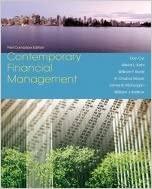A carpet company has produced and sold about 150 million square yards of carpet over the last 15 years that is expected to still be on the floors of buildings. They are contemplating how to deal with this waste stream since it is likely to come back to them over the next ten years at a roughly constant rate. Carpet weighs about 9 lbs/square yard They are considering two options 1) Install a co-generation unit at their manufacturing plant and use the waste carpet to generate process steam. This would require that they ship the carpet back from the places it is removed to their manufacturing facility. 2) Send the carpet to waste-to-energy incineration near where it is removed. For the first option the capital cost of the co-generation unit is $20 million dollars and will be a depreciable capital asset with a 10 year life. The salvage value will be taken at the end of year 10 and is assumed to be $2 million dollars. The steam will be worth $2/MMBtu. The logistics cost of shipping the carpet to the plant is approximately $0.05/lb. The carpet fuel value is 22,000 btu/lb. For the second option there is no capital outlay but each ton of carpet costs about $80/ton to send to waste to energy and the logistics costs of shipping the carpet to those facilities is on average $0.01/lb. It is expected that the costs of sending the material to waste to energy will inflate at 3% per year. It is expected that transportation costs will inflate at 4% per year for both options. The tax rate will be 40%. The co-generation plant will be built in year 1 but both systems will start operating in year 2 and continue operations through year 11. The capital may be taken to be spent at the end of year 1 and depreciation also started at the end of year 1 and be taken to be straight line depreciation from year 1 to year 10 In both cases working capital is required at the end of year 1 and returned at the end of year 10. The working capital is equal to 2 months of the expected carpet flow multiplied by the amount of money it will take to ship and/or ship and process the carpet depending on the option. Using a strictly economic argument based on the net present values of the two options, with a discount factor of 15%, which option would you recommend to the company? Why might the company choose to go with the other option. A carpet company has produced and sold about 150 million square yards of carpet over the last 15 years that is expected to still be on the floors of buildings. They are contemplating how to deal with this waste stream since it is likely to come back to them over the next ten years at a roughly constant rate. Carpet weighs about 9 lbs/square yard They are considering two options 1) Install a co-generation unit at their manufacturing plant and use the waste carpet to generate process steam. This would require that they ship the carpet back from the places it is removed to their manufacturing facility. 2) Send the carpet to waste-to-energy incineration near where it is removed. For the first option the capital cost of the co-generation unit is $20 million dollars and will be a depreciable capital asset with a 10 year life. The salvage value will be taken at the end of year 10 and is assumed to be $2 million dollars. The steam will be worth $2/MMBtu. The logistics cost of shipping the carpet to the plant is approximately $0.05/lb. The carpet fuel value is 22,000 btu/lb. For the second option there is no capital outlay but each ton of carpet costs about $80/ton to send to waste to energy and the logistics costs of shipping the carpet to those facilities is on average $0.01/lb. It is expected that the costs of sending the material to waste to energy will inflate at 3% per year. It is expected that transportation costs will inflate at 4% per year for both options. The tax rate will be 40%. The co-generation plant will be built in year 1 but both systems will start operating in year 2 and continue operations through year 11. The capital may be taken to be spent at the end of year 1 and depreciation also started at the end of year 1 and be taken to be straight line depreciation from year 1 to year 10 In both cases working capital is required at the end of year 1 and returned at the end of year 10. The working capital is equal to 2 months of the expected carpet flow multiplied by the amount of money it will take to ship and/or ship and process the carpet depending on the option. Using a strictly economic argument based on the net present values of the two options, with a discount factor of 15%, which option would you recommend to the company? Why might the company choose to go with the other option







